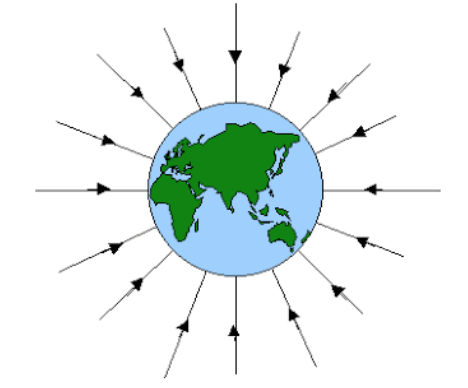3.4 Gravitational Field and Acceleration Due to Gravity on Different Planets
Overview
The gravitational field, denoted by , represents the force per unit mass acting on an object in a specific region of space. This field is responsible for the gravitational force that acts on objects, causing them to accelerate toward the center of a planet or star.
On Earth, has a value of 9.8 m/s², but it varies on other planets depending on their mass and radius. Let’s explore how gravitational fields work and how to calculate for any celestial body.

What Is a Gravitational Field?
A gravitational field is a region around a mass where another mass experiences a force due to gravity. Its strength is expressed as the gravitational force per unit mass:
In simpler terms, is the acceleration due to gravity an object experiences in a given gravitational field.

Key Properties
- Direction: Always points toward the center of the mass generating the field.
- Magnitude: Determined by the mass of the celestial body and the distance from its center.
- Radial Nature: For spherically symmetric objects, the gravitational field decreases as the inverse square of the distance from the center.
Deriving Gravitational Field Strength
Using Newton’s Universal Law of Gravitation:
Combine this with :
Where:
- is the gravitational field strength (m/s²),
- is the gravitational constant (),
- is the mass of the planet (kg),
- is the distance from the planet’s center (m).
This equation allows us to calculate for any celestial body.
Key Insights
- Mass-Independent: does not depend on the mass of the object experiencing the gravitational field.
- Distance Matters: includes the radius of the planet and any additional height above the surface.
- Universal Application: The equation works for all spherically symmetric masses, from planets to stars.
Gravitational Acceleration on Different Planets
The value of varies based on the mass and radius of a planet. For example:
- Earth:
- Mars:
- Jupiter:
The larger and denser a planet, the stronger its gravitational field.
Practice Problems
Problem 1:
How does change if the mass of a planet is doubled?
- a) It remains the same.
- b) It is halved.
- c) It is doubled.
- d) It is quadrupled.
Answer: c) It is doubled.
Explanation: Since , doubling the mass doubles .
Problem 2:
A planet has a mass of and a radius of . Calculate .
- a)
- b)
- c)
- d)
Answer: b)
Explanation:
Problem 3:
How does change if the distance between two masses is doubled?
- a) It remains the same.
- b) It is halved.
- c) It is quartered.
- d) It is doubled.
Answer: c) It is quartered.
Explanation: Since , doubling the distance reduces to one-fourth.
Problem 4:
An object is away from a star with a mass of . Calculate the gravitational force acting on the object.
- a)
- b)
- c)
- d)
Answer: d)
Explanation:







